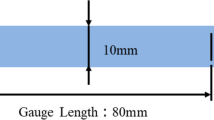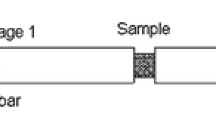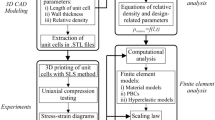Abstract
Nowadays, polyamide 12 (PA-12) is considered as an interesting polymer in the rotomolding process to manufacture different pieces like the liner part in the storage hydrogen tank (type IV). In this study, the pure polyamide-12 and PA12 pieces, incorporated with 0.5%, 1% and 3% wt Nano Carbon Black (NCB), were manufactured by the rotomolding process. Different rotomolding parameters such as heating temperature, time of heating, and cooling rate have been optimized to obtain the ideal piece. The effect of volume fraction of NCB in terms of physicochemical and mechanical properties has been studied. Afterward, the optimal volume fraction of NCB is revealed using different characterization methods. The tensile results specified the addition of NCBs until 0.5% improved the tensile behavior. The addition of NCBs more than 0.5% decreases the mechanical properties in terms of failure stress and strain, while it has no significant effect on the elastic modulus of PA-12. The bi-parabolic the Perez model has been used to study the viscoelastic behavior of PA-12 using the Cole-Cole method. The constants of the Perez model indicate a good correlation between viscoelastic experimental results and the model used.











Similar content being viewed by others
References
Greco A, Ferrari F, Buccoliero MG, Trono G (2019) Thermal and mechanical analysis of polyethylene homo-composites processed by rotational molding. Polymers (Basel) 11(3):1–16
R. A. M. Jaziri, “Reactive rotational molding process of PP/PA6 bilayer systems: experimental investigations,” Int J Mater, no. 65, p. 21, 2013
S. Pivsa-Art, S. Thumsorn, S. Pavasupree, N. O-Charoen, and W. Pivsa-Art, “Effect of poly(butylene adipate-co-terephthalate) contents on crystallization and mechanical properties of polymer blends of poly(lactic acid) and poly[(butylene succinate)-co-adipate],” Annu. Tech. Conf. - ANTEC, Conf Proc, vol. 3, pp. 2437–2441, 2013
Chang H, Li Q, Xu C, Li R, Wang H et al (2017) Wool powder: An efficient additive to improve mechanical and thermal properties of poly(propylene carbonate). Compos. Sci. Technol. 153:119–127
Vilakati GD, Hoek EMV, Mamba BB (2014) Probing the mechanical and thermal properties of polysulfone membranes modified with synthetic and natural polymer additives. Polym Test 34(202–210):2014
Maskery I et al (2018) Insights into the mechanical properties of several triply periodic minimal surface lattice structures made by polymer additive manufacturing. Polymer (Guildf). 152:62–71
Ramezani, Dana H, Barbe F, Delbreilh L, Azzouna M, Guillet A, Breteau T (2019) Polymer additive manufacturing of ABS structure: influence of printing direction on mechanical properties. J Manuf Process 44:288–298
Kang E, Choi B, Park W, Kim I, Han D (2019) One step bulk modification of poly(L-lactic acid) composites with functional additives to improve mechanical and biological properties for cardiovascular implant applications. Colloids Surfaces B Biointerfaces 179:161–169
Li Z, Fan F, Xia Z, Li Q (2013) Effects of inorganic fillers on the shear viscosity and fire retardant performance of waterborne intumescent coatings. Prog Org Coatings 76(5):844–851
Seleem HEH (Jun. 2006) The effect of inorganic fillers on the mechanical and thermal properties of polyester. Polym Plast Technol Eng 45(5):585–590
Meincke DK, Ogliari AO, Ogliari FA (2016) Influence of different fillers on the properties of an experimental vinyl polysiloxane. Braz Oral Res 30(1):1–10
Tcharkhtchi JVA (2004) Structure-processability relationships during rotational moulding of plastics. Adv Eng Mater 6(12):983–992
Crawford R, Cramez MC, Oliveira MJ, Spence A (2002) The Importance of Monitoring Mold Pressure During Rotational Molding
“pericles_1548263444.”
Gogos G (Feb. 2004) Bubble removal in rotational molding. Polym Eng Sci 44(2):388–394
Benzaine M, Tcharkhtchi A, Hafsaoui SL (2013) Thermal transfer simulation regarding the rotational moulding of polyamide 11. J Therm Anal Calorim 112(1):285–292
Tcharkhtchi A, Perrot E, Chinesta F (2004) Simulation of thermal phenomena on the interphase molten polymer-powder polymer during rotational moulding,Plastics. InterPolymer Process XIX 3:296–302
Sarrabi ATS, Boyer SAE, Lacrampe MF, Krawczak P (2013) Metallocene polypropylene crystallization kinetic during cooling in rotational molding thermal condition. J Appl Polym Sci 130(1):222–233
Bergamo L, Spa P (2019) “https://rotoworldmag.com/measurement-and-control-of-pressure-inside-rotational-moulds/,” Measurement and Control ofPressure Inside Rotational Moulds
K. R. Kent R (2016) Processing quality management, Qual. Manag. Plast. Process., pp. 293–336
Sari P, Thomas S, Spatenka P, Ghanam Z, Jenikova Z (2019) Effect of plasma modification of polyethylene on natural fibre composites prepared via rotational moulding. Compos Part B Eng 177:107344
Kulikov O, Hornung K, Wagner M (2009) Novel processing additives for rotational molding of polyethylene. Int Polym Process 24(5):452–462
Robert A, Tcharkhtchi MKA, Briot J, Crawford RG (2001) Rotomoulage du polyéthylène chargé Mica. matériaux Tech. 9–10:37–43
Arkema (2005) “Rilsan PA 11,” Datasheet, pp. 1–32
Greco A, Maffezzoli A, Forleo S (2014) Sintering of PLLA powders for rotational molding. Thermochim Acta 582:59–67
Gomes FPC, Thompson MR (2018) Nondestructive evaluation of sintering and degradation for rotational molded polyethylene. Polym Degrad Stab 157:34–43
Nugent P (2011) 18 - rotational molding. William Andrew Publishing
Farzaneh S, Hafsaoui ATSL, Mahmoud R (2013) Study of polyamide 12 crystallization behavior within rotational molding process. Iran. Polym. J. 22(3):187
Nugent P (2017) 15 - rotational molding. William Andrew Publishing
Ebnesajjad S (2003) 9 - rotational molding and linings. William Andrew Publishing, Rotational Molding and Linings
Tcharkhtchi A, Rotomoulage de pièces en matière thermoplastique, Tech. l’ingénieur, vol. AM 3706, pp. 1–15
Fu JF, Yu WQ, Dong X, Chen LY, Jia HS, Shi LY, Zhong QD, Deng W (2013) Mechanical and tribological properties of natural rubber reinforced with carbon blacks and Al2O3 nanoparticles. Mater Des 49:336–346
Guo S et al (2019) Enhanced mechanical properties and electrical conductivity of graphene nanoplatelets/Cu composites by in situ formation of Mo2C nanoparticles. Mater. Sci. Eng. A 766(August):138365
Ceran ÖB, Şimşek B, Doruk S, Uygunoğlu T, Şara ON (2019) Effects of dispersed and powdered silver nanoparticles on the mechanical, thermal, electrical and durability properties of cementitious composites. Constr Build Mater 222:152–167
Montazeri A, Pourshamsian K (2012) Viscoelastic properties and determination of free volume fraction of multi-walled carbon nanotube/epoxy composite using dynamic mechanical thermal analysis. Mater Des 36:408–414
Ferry JD (1970) Viscoelastic properties of polymers, 2nd edn. John Wiley, New York
Montazeri A (2013) The effect of functionalization on the viscoelastic behavior of multi-wall carbon nanotube/epoxy composites. Mater Des 45:510–517
Author information
Authors and Affiliations
Corresponding authors
Ethics declarations
Conflict of interest
There are no conflicts of interest to disclose.
Additional information
Publisher’s note
Springer Nature remains neutral with regard to jurisdictional claims in published maps and institutional affiliations.
Rights and permissions
About this article
Cite this article
Shirinbayan, M., Montazeri, A., Nouri Sedeh, M. et al. Rotational Molding of Polyamide-12 Nanocomposites: Modeling of the Viscoelastic Behavior. Int J Mater Form 14, 143–152 (2021). https://doi.org/10.1007/s12289-020-01558-9
Received:
Accepted:
Published:
Issue Date:
DOI: https://doi.org/10.1007/s12289-020-01558-9




